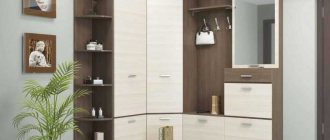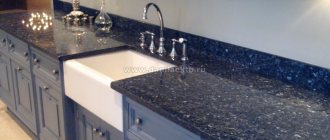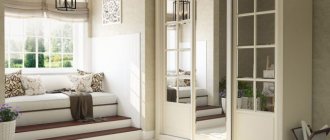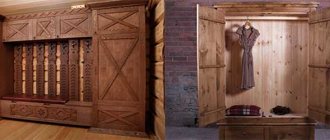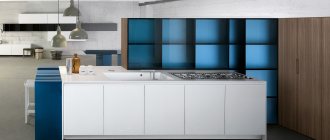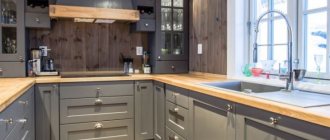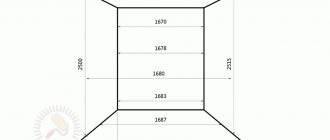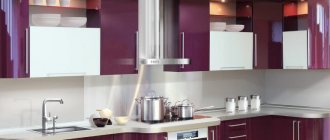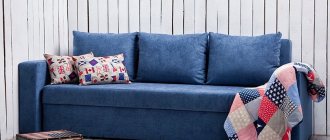Calculation of façade weight online
Facade material
MDF in film or plastic Laminated chipboard Acrylic glass on MDF Glass in an aluminum frame Solid oak Solid beech Solid alder
Facade dimensions
| Thickness | mm |
| Height | mm |
| Width | mm |
Please note that the calculation does not take into account the weight of the fittings (handles, hinges and mechanisms). To calculate the weight of the facade, the average value of the material density is taken.
Use the service to draw drawings of additives for facades.
To calculate the weight of a part, please select a material.
Enter the dimensions - width, height and thickness of the part.
Click on the “Calculate” button.
The information is for reference only, for values based on materials MDF, chipboard, Oak, Pine, an error within 10% is possible.
This is due to the level of humidity, the density of the material, and the coating (MDF and chipboard) of various board manufacturers.
When choosing a lifting mechanism for a facade, take into account the weight of the furniture handle; in intersecting areas, choose a mechanism with a higher load capacity.
Calculation of the facade is especially important when designing furniture, selecting fittings and mechanisms for cabinet furniture, since all mechanisms have a permissible design load. If it is exceeded, the mechanisms will wear out and not fully perform their functions. The simplest and most accurate way out of this situation is to weigh the facade on a scale or request information from facade manufacturers. But there are a number of reasons why the above method is not suitable. Depending on the manufacturers of the materials used, the weight of the facade can be calculated using the formula, knowing the density (kg/m3) of the facade material and its dimensions in meters. Below is the approximate density range of the main materials from which facades are made:
Density of chipboard - 600 - 750 kg/m3 - average value 700 kg/m3
Density of MDF - 720 - 870 kg/m3 - average value 750 kg/m3
Density of Solid Wood:
Glass density - 2500-2600 kg/m3 - average value 2550 kg/m3
Density of Aluminum - 2700 kg/m3
Knowing the density of the material and the dimensions of the facade, the weight of the facade can be calculated using the formula
Facade calculation in kilograms = facade height (m) * facade width (m) * facade thickness (m) * material density (kg/m3)
For example, you need to calculate the weight of an MDF facade
Dimensions: height 720 mm, width 900 mm, thickness 18 mm
Facade weight calculation : 0.72*0.9*0.018*750=8.748 kg
This is a method of calculating the weight of a façade as close as possible to reality, since average values are used in the density value and the shape of the façade is not taken into account.
If handles are installed on the facade, their weight must also be taken into account.
Width
The standard panel width is 150-190 mm; it is very rare to find 900 or 1200 mm MDF on the open market. The width largely determines the aesthetics and decorativeness of the finish: the wider the panel, the fewer joining seams on the coating and the smoother the surface appears.
The external dimensions and thickness of the panel play a key role. Weight according to dimensions is given in the tables above.
Let's see how the weight of an MDF panel measuring 2,800*2,050 mm (the maximum value on the market) will change, depending on the thickness of the product:
- 3 mm – 16 kg.
- 6 mm – 31 kg.
- 12 mm – 60 kg.
- 22 mm – 106 kg.
- 28 mm – 142 kg.
It is worth noting that the weight of the decorated panels will vary slightly upward.
What determines the mass of the product?
The weight of an interior door directly depends on the quality of the material from which it is made. Factory models are manufactured in accordance with state standards and have standard parameters: size and weight.
Materials, in turn, have such a property as density. The specifics of the material from which the product is made directly affects how much the door weighs. Here are the densities of the most common materials:
Average weight of a door made of this material, kg
1.5 kg per linear meter
Glass (thickness 5 mm)
Coniferous wood processing products
hardwood tree
How to correctly calculate the cabinet front
Summarizing everything written above. It doesn’t matter how much you reduce the façade relative to the frame. The main principles for calculating dimensions for cabinet doors or cabinets with drawers, chests of drawers are as follows:
- The play for hinged and retractable facades for the possibility of adjusting the hinges must be at least 2 mm in width. In terms of height, if there is no limiting canopy and/or protruding bottom, this principle is not important.
- It is imperative to take into account the thickness of the edge when calculating the final size of the facade. PVC 2mm thick on both sides is already 4mm! This means that you need to subtract at least 7 mm from each side for the gap to take into account the thickness of the edge.
- The principle of calculating facades must be observed for the entire set of furniture. Especially if there is a certain rowing, the adjoining of several diverse facades to each other.
This last principle is especially important for kitchens. Let's look at it in more detail.
A lot of different doors, their advantages and disadvantages
Each of the materials has its own advantages and disadvantages.
Plastic has unsurpassed insulating properties. It retains heat perfectly, cuts out odors and noise. Models made from this material are light in weight and have a reduced risk of injury. Moreover, they are affordable. The main disadvantage of these models is their lack of environmental friendliness and even toxicity. Therefore, it is not recommended to install them in residential buildings. An exception may be products made from high-quality plastic, the cost of which is comparable to wooden models.
An interior door with glass looks laconic and attractive. These models allow you to give the room airiness, lightness to the interior, and let a large amount of sunlight into the room. Modern tempered glass or triplex is characterized by high impact strength and safety. However, their price makes you think about the feasibility of installing such a model.
Models made using wood processing products are considered a worthy replacement for solid analogues. They are more affordable, resistant to moisture and temperature changes. In addition, wood chip material weighs less compared to solid wood. Finishing from valuable wood veneer gives the product a respectable appearance.
Products of new technologies are alternative synthetic materials that cover the canvas to give not only an external gloss, but also to improve significant consumer qualities. New generation materials include artificial veneer (laminate), nanoflex and eco-veneer. They are considered a model of environmental friendliness and are highly resistant to moisture and temperature changes. The polymer coating ensures that the veneer door weighs less.
What to consider when calculating the dimensions of furniture facades
I have already written about how to calculate the dimensions of the fronts of a corner cabinet here. Now we will talk about ordinary ones.
There are two types of facades - overhead and inset (internal).
According to the generally accepted standard, overhead facades of any furniture and any plan (hinged, retractable) should be reduced by 3-4 mm from the dimensions of the cabinet/niche that they cover. The same rule applies for internal facades, but the calculation is based on the internal dimensions of the niche.
To be honest, I am calm about deviations from generally accepted norms in the calculation of furniture facades. The beauty of making furniture yourself, either with your own hands or to order, is that you can implement some non-standard solutions.
Is it possible to make the gaps on the facades smaller?
I remember there was a customer who really wanted the kitchen facades to fit very tightly together, forming a kind of monolithic effect. Moreover, it was important to him that the edge of the facades be as straight as possible, without roundings. For this reason, MDF facades were rejected immediately. He was categorically not satisfied with how the edge of PVC with a thickness of 2 mm and even 1 mm was “rounded”.
PVC with a thickness of 0.4 mm was purchased specifically for it.
The size of the fronts was reduced by only 2mm, excluding the thickness of the edges. The customer personally checked and approved all the dimensions of the facade that went into production - the appearance of the furniture was so important to him. Well, of course, I was warned about the minimum play for opening doors and drawers, in order to avoid them shuffling away from each other. The most subtle point was the large drawers at the bottom of the kitchen. It is natural that they sag a little, once they are loaded to capacity. They are regulated when the kitchen is installed empty. And loaded ones may well “climb” onto each other and begin to shuffle when opening, if the play between them – in his case only 1 mm – is minimal. But the customer vowed not to overload them and not to make any complaints about this.
Is it possible to make the gaps on the facades larger?
There was also the opposite case in my practice. When huge gaps between the facades emphasized the special design of the furniture. It looked really very interesting and stylish. I only have a photo of the shoe rack and it’s not in very good quality. But the principle of calculating cabinet facades is visible from the photograph.
The furniture body also adapts to such design techniques. So that the gaps between the doors, through which all the insides “shine,” are not visible.
There is one caveat if you want to use the same solution - make the doors smaller relative to the body so that the sides are visible. If the facades are hinged, then they are mounted not on a regular 90-degree hinge, but on a semi-overlay hinge, specially designed for opening at the “half end”. You can read more about loops here. Accordingly, the doors need to be reduced by the amount of “half the end”, that is, 8-10 mm.
For drawers, the size of the fronts, while significantly reduced relative to the edges of the niche, does not in any way affect its ability to slide out.
Factors influencing the weight of an interior product
Other factors also influence the weight of the door:
- Dimensions of the canvas (length, width and thickness). Models made of the same material, the same height and width, but differing in thickness by several millimeters will have a difference in weight of several kg (depending on the material);
- Uniformity of the material. Products can be solid and glazed, made from one material or contain a combination of materials with different densities. All these nuances are reflected in the mass of products.
- Its production technology:
- The heaviest doors will be solid wood doors, whose weight can reach 140 kg.
- Slightly lighter than panel type products. Interior doors made of veneer contain fragments of wood materials (chipboard, MDF). The upper part of such products may contain inserts in the form of panels, glass, or cardboard with a cellular structure. The heaviness of the model will depend on the quality of the insert. It ranges from 20-40 kg.
- Panel products have a hollow structure. The cavities are usually filled with cardboard inserts in the form of a honeycomb. These models are distinguished by their low weight - 10-15 kg.
- The quality of the fittings used. Door handles, locks and other accessories add more weight to the product.
Calculation of the opening for a canvas of unified width
To the height and width of an interior door made of veneer, as well as other types of coatings, you need to add the dimensions of the frame and installation gaps (technological spaces). This is a simple calculation algorithm. Wherein:
- The box (box) usually measures 25 mm on each side. This indicator can change in proportion to the working load on the frame (door weight).
- Gaps for installation are limited to 15-20 mm. They are needed to secure the box in the wall and level out unevenness and slope deviations.
- Between the door and the door leaf there should be a gap of 2.5-3 mm on both sides (5-6 mm in total) in order to guarantee free closing and hanging of the hinges.
- The standard threshold height is 15-25 mm. If this is not done, then a gap remains between the interior door and the floor surface.
- Let's calculate the dimensions of the opening for a standardized canvas 2000x800 mm.
- Height: 2000 + 25 (frame) + 25 (threshold or gap under the doors) + 20 (upper installation gap) + 3 (for unhindered movement of the door in the frame) = 2075 mm. After rounding it will be 2080 mm.
- Width: 800 + 2*25 (frame) + 2*20 (installation gaps) +5 (clearance for free hanging and movement of the door in the frame) = 895 mm. If we round, we get 900 mm.
Thus, for a door 2000x800 mm, an opening of 2080x900 mm is needed (80 mm higher and 100 mm wider). If the opening dimensions are 2-3 cm larger than the calculated ones on each side, this excess can be removed using polyurethane foam. If there are large gaps, the opening will have to be adjusted.
Why do you need to know the weight of the door?
The weight of the canvas needs to be known for several reasons.
Firstly, this information is needed to correctly select a door frame if it is not included in the package. If you hang a heavy solid product on an MDF box, then such a structure will not last long.
Loops are also selected based on the weight of the product. Doors of various designs have their own subtleties of location and attachment to the frame.
Secondly, the weight of the door will allow the apartment owners to plan the correct placement of it. Heavy products will be inappropriate in a nursery or bathroom. This will create unsafe living conditions and cause operational difficulties.
How much does the finished product weigh?
So, how much does a metal door weigh? The lightest are Chinese metal products, they weigh about 40 kg, are usually powder coated with a sheet thickness of no more than 2 mm and do not have any additional linings. Such products are not able to provide reliable protection for the apartment. The optimal weight of a metal door for an apartment is 60-70 kg; such doors are most often covered with laminate, veneer or MDF panels. Structures finished with solid natural wood often weigh more than 100 kg.
An entrance door covered with laminate or MDF panels weighs about 70 kg
The weight of heavy-duty metal structures with a double or triple layer of steel can reach 150 kg or more.
Of course, such a door will provide the most reliable protection, but too massive structures can cause certain inconvenience during installation, and, moreover, heavy doors sag over time. Therefore, during long-term use, it is necessary to regularly adjust the position of the blade by adjusting the hinges.
When choosing a metal structure, you should focus not only on its weight, but also on the manufacturer. Companies that care about their reputation will not use low-grade raw materials and unnecessarily make products heavier, and will direct all efforts to the strength and reliability of the design.
We recommend watching the video
MDF door weight
When buying interior doors, we will definitely pay attention to their color, texture, i.e. external signs that tell us how they will fit into the interior of our house or apartment, and, of course, their cost.
What about the functionality of doors?
This question is also important for many reasons: doors come from different materials (for example, solid or laminated wood, MDF, plastic and glass), each of which has its own advantageous and, perhaps, not so good characteristics: moisture resistance, wear resistance and their weight.
It is the weight characteristics that will be discussed.
› Additional features
Online calculator
For your convenience, we have developed an online door calculator in which you can:
- • select the type of door and indicate its dimensions;
- • choose the type of glass and its decoration;
- • select accessories;
- • make an accurate cost calculation (excluding delivery to your city).
After receiving your application, we will contact you during business hours at the specified telephone number.
Free consultation with a design engineer
Consultation with a qualified specialist will help you in case of:
- • if you do not know how to choose the appropriate type of glass or set of fittings;
- • if you have a complex or non-standard project;
- • if you need to make an accurate cost calculation;
- • if you have any other question about glass doors.
After receiving your application, we will contact you during business hours at the specified telephone number.
Call a surveyor
You can call our specialist to carry out professional measurements:
- • to calculate the exact dimensions of the doorway;
- • to conduct an inspection of the installation site of the door and its fastening;
- • to receive recommendations on the choice of fittings and method of fastening;
- • to take into account other features of the installation site and further design of the structure.
After receiving your application, we will contact you during business hours at the specified telephone number.
Standard door weight parameters
The weight of the door is determined primarily by what material it is made of. For example:
- plastic used for interior doors - about 1.5 kg. per 1 linear meter + 1 kg. per 1 sq. m. – profile reinforcement;
- glass 5 mm thick weighs approximately 12.5 kg. per 1 sq. m.;
- wood (glued, pressed), usually not very expensive, but fairly high-quality coniferous (soft) wood, for example, pine - weight 1 square meter, about 15 kg. per 1 sq. m.;
- wood (solid), for example, oak or ash - deciduous (hard) wood reaches a weight of 20-25 kg. per 1. sq.m.
If you do some simple arithmetic, you can calculate that a standard blind canvas measuring 2 m by 0.6-0.9 m will have the following weight (including accessories: locks and handles):
- plastic door - about 4.5 kg;
- glass – 20 kg;
- for a wooden one it will range from approximately 24 kg. up to 40 kg.
But material is not a “pure” indicator of weight. It is also important how this door is made.
So, for example, there are solid products with windows (made of glass or plexiglass), hollow (like, for example, all MDF panels) and solid (made of solid wood or laminated), hinged or sliding doors.
How does this factor affect the weight of the doors?
Essential: both in the direction of making them lighter and heavier.
When calculating the weight of blind swing structures, it is enough to take into account only the weight of the material from which they are made.
But the same solid, but sliding products (made of solid wood) can reach a weight of 125 kg, because... The dimensions of the door leaf change (from floor to ceiling)
Solid MDF doors (laminated, veneered and painted), made (using technology) hollow and cellular, like a honeycomb (using cardboard), inside, weigh approximately 10 kg. But if you put glass in them, they will become a little heavier (depending on the area of the glass being installed).
Manufacturing materials
The decisive factor for the weight of the product is the material of manufacture.
- Solid wood is the most expensive, but also the most attractive material. The door leaf in this case is made of a solid wooden panel and is distinguished by excellent heat and sound insulation. However, it has maximum weight. On average 1 sq. m of array weighs up to 20–25 kg. The higher the hardness and density of the wood, the heavier the product made from it. The heaviest ones are oak doors. The photo shows an oak interior door.
What determines the mass of the product?
The weight of an interior door directly depends on the quality of the material from which it is made. Factory models are manufactured in accordance with state standards and have standard parameters: size and weight.
Materials, in turn, have such a property as density. The specifics of the material from which the product is made directly affects how much the door weighs. Here are the densities of the most common materials:
Average weight of a door made of this material, kg
1.5 kg per linear meter
Glass (thickness 5 mm)
Coniferous wood processing products
hardwood tree
Online sheet material calculator
This online calculator allows you to calculate the required quantity of any building sheet materials, such as plywood, OSB, chipboard, fibreboard, MDF, chipboard, plasterboard, laminate, tiles, foam plastic, mineral wool, etc.
Our calculator will be especially useful if you need to calculate the consumption of building materials for:
The weight of plywood is calculated automatically when placing an order through the cart of our online store.
Please note that the calculator calculates the minimum possible consumption, so do not forget about some supply of materials. The consumption of materials can be affected by the number of corners of the working surface, their configuration, the thickness of the seams in the joints between sheets, the amount of overlap, etc.
Directly from this page you can quickly order the materials you need by indicating in the address field the name of the product, the desired sizes and number of sheets.
There is also a section on our website where you can create a cutting map for sheet materials:
All plywood in this video is provided by our company. High-grade sanded birch plywood 6-10-20 mm large format was used
EXPERIENCE
QUALITY ASSURANCE
SERVICE
A lot of different doors, their advantages and disadvantages
Each of the materials has its own advantages and disadvantages.
Plastic has unsurpassed insulating properties. It retains heat perfectly, cuts out odors and noise. Models made from this material are light in weight and have a reduced risk of injury. Moreover, they are affordable. The main disadvantage of these models is their lack of environmental friendliness and even toxicity. Therefore, it is not recommended to install them in residential buildings. An exception may be products made from high-quality plastic, the cost of which is comparable to wooden models.
An interior door with glass looks laconic and attractive. These models allow you to give the room airiness, lightness to the interior, and let a large amount of sunlight into the room. Modern tempered glass or triplex is characterized by high impact strength and safety. However, their price makes you think about the feasibility of installing such a model.
Models made using wood processing products are considered a worthy replacement for solid analogues. They are more affordable, resistant to moisture and temperature changes. In addition, wood chip material weighs less compared to solid wood. Finishing from valuable wood veneer gives the product a respectable appearance.
Products of new technologies are alternative synthetic materials that cover the canvas to give not only an external gloss, but also to improve significant consumer qualities. New generation materials include artificial veneer (laminate), nanoflex and eco-veneer. They are considered a model of environmental friendliness and are highly resistant to moisture and temperature changes. The polymer coating ensures that the veneer door weighs less.
Models made from deciduous (hard) wood are considered an attribute of luxury. Their cost is really high, but it is compensated by the advantages. These products are reliable, wear-resistant and very beautiful. However, wood can quickly lose its appearance due to sudden temperature changes and high humidity in the room. To ensure that the wooden door does not deform due to unfavorable factors, it is coated with special moisture-resistant compounds. The weight of such products, depending on the type of wood, can reach up to 150 kg. This means that the load on the door hinges will be maximum; especially durable fittings and a high-quality wooden frame will be required.
PVC models are practically indistinguishable in appearance from solid ones or from products with veneer. They are resistant to adverse external factors, aesthetically pleasing and practical to care for.
What material to choose for interior doors and exterior coverings
The right interior door to an apartment must meet three requirements: beautiful, practical, inexpensive. The choice of material and finish will depend on how you prioritize. For some, it is important that the door is also environmentally friendly; manufacturers also take this criterion into account.
The most common materials for making interior doors are:
- Solid wood. Advantages: reliability and quality; environmental friendliness; good sound insulation. Disadvantages: high price; sensitivity to changes in humidity and tendency to dry out. Wet cleaning is not recommended.
- Pine bars. Advantages: environmentally friendly. Disadvantages: the price is higher than that of synthetic materials.
- Chipboard. The material is cheaper than MDF, not to mention solid wood. Disadvantages: in the production of chipboard, synthetic substances (binder resin with formaldehyde) are used that are harmful to the body. Such slabs are safe only if all edges and technological holes are sealed and covered with laminate.
- MDF. Advantages: strength; water resistance; The material is easy to process, which allows you to make various designs. Manufacturers who write that MDF is “several times more environmentally friendly than chipboard” are misleading you. They have the same binding base. GOST requirements for the safety of MDF products are exactly the same. Disadvantages: the price is higher than that of chipboard.
- Cellular cardboard. Advantages: low price. Disadvantages: fragility.
The internal “filling” of the door is not visible; what is often more important is what material the door leaf is covered with. At home, we interact with doors constantly and we want the door to last longer, maintaining its original appearance, washed and cleaned without any problems. The interior door can be plastic, laminated, veneered, or with PVC film.
The advantages of laminate are its affordable price, excellent protective and decorative properties. The material is sensitive to aggressive environments (high humidity and temperatures). PVC film is characterized by strength and can be made in different designs. However, this is not a natural coating.
Natural veneer or a thin sheet up to 10 mm, which is chipped, sawed, peeled from a piece of wood, is environmentally friendly, pleasant to look at, does not like high humidity (not suitable for a bathroom door). It can be replaced with eco-veneer, it is cheaper, but looks almost the same. You can choose an interior door with glass inserts. Moreover, this will not greatly affect the sound insulation. There are also no questions about the strength of modern materials: tempered door glass or triplex glass made from organic and silicate compounds must still be broken.
Factors influencing the weight of an interior product
Other factors also influence the weight of the door:
- Dimensions of the canvas (length, width and thickness). Models made of the same material, the same height and width, but differing in thickness by several millimeters will have a difference in weight of several kg (depending on the material);
- Uniformity of the material. Products can be solid and glazed, made from one material or contain a combination of materials with different densities. All these nuances are reflected in the mass of products.
- Its production technology:
- The heaviest doors will be solid wood doors, whose weight can reach 140 kg.
- Slightly lighter than panel type products. Interior doors made of veneer contain fragments of wood materials (chipboard, MDF). The upper part of such products may contain inserts in the form of panels, glass, or cardboard with a cellular structure. The heaviness of the model will depend on the quality of the insert. It ranges from 20-40 kg.
- Panel products have a hollow structure. The cavities are usually filled with cardboard inserts in the form of a honeycomb. These models are distinguished by their low weight - 10-15 kg.
- The quality of the fittings used. Door handles, locks and other accessories add more weight to the product.
Calculation of the number of four-hinged hinges
| Facade material | |
| Width (mm) | |
| Height (mm) | |
| Weight, kg) | |
| For the facade it is necessary | |
| Note: — This information is for reference only; — If you have any doubts, it is better to make a prototype; — To increase the maximum load, the distance between the loops must be the same; — Furniture handles can significantly increase the overall weight of the facade. | |
| Hinges with cup 26 mm Don't forget to purchase dampers Hinges with cup 35 mm Don't forget to purchase dampers Hinges with cup 40 mm | |
Don't forget to purchase dampers
Don't forget to purchase dampers
Hinges for aluminum profiles
Don't forget to purchase dampers
And you will always be aware of the latest events, new products and promotions!
Source
Weight indicators for different types of wood
The main parameters affecting the weight of wooden doors are:
- type of wood;
- solid or glued material is used for manufacturing.
Deciduous trees with durable wood are heavier than conifers. For example, a standard ash or oak panel with an area of 1 sq.m. will weigh between 20 and 25 kg. The weight of the whole sash will be 35-45 kg.
A meter square of solid pine canvas is much lighter - only 15 kg. The weight of a laminated sash of the same area will be higher due to the presence of small particles of different wood species in the material.
Glass or mirror inserts lighten the weight of the structure. Durable glass 5mm thick. and an area of 1 sq.m. weighs only 12.5 kg. Even lighter are linings and inserts made of polymers and composite materials.
Single leaf door made of ash with glass inserts
Fragile structures with an empty middle or doors whose core is filled with cellular cardboard weigh the least. The weight is slightly increased by covering it with clapboard or panels made of plastic or wood. In any case, lightweight structures are not the most durable and practical option for installation in the passages between rooms.
Additional weight is given to the doors by decorative elements, protective linings, additional locks and reinforced fittings. Thick tempered or laminated glass certainly increases the protective characteristics of the product, but also makes it significantly heavier.
